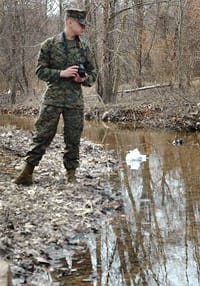The making of a combat correspondent, a young Marine’s story. Part I
Note: Last year a young man called CCHQ from Berkeley, CA wanting to interview me about the CCs as he was waiting to go to recruit training and then become a CC. We didn’t hear anything until very recently when former President Keith Oliver informed us that the young Marine had completed the basic MOS training at DINFOS to become a CC and had been assigned to II MEF at Camp Lejeune. We decided it might be interesting to follow LCpl. James Clark as he begins his career as a new combat correspondent. We will run letters from him occasionally to follow his progress. Here is his first.)
The training, learning the craft.

LCpl. James Clark at DINFOS.
By LCpl. James Clark
There are some experiences every Marine has shared. Some words everyone has heard. Words that will never leave you.
“You are no longer an I or a me. You are a recruit. You will speak when spoken to. You will do exactly what you are told when you are told. When asked a question you will answer with yes sir, or no sir. When given an order you will follow it and will respond with aye aye sir. Is this understood?”
“YES SIR!” “Now get off my bus!” “Aye aye sir!”
Shuffling off the bus and onto those foot prints you step into your new shoes. Over the next three months you learn wear them. You march, run, climb, jump and swim in them. You fight sweat and bleed in them.
When you step on the yellow foot prints, you become a recruit, and months later when you walk off the parade deck you leave them behind because you have become a Marine.
When you leave recruit training you head off to Marine combat training and then on to school where you will be trained in your military occupational specialty.
However for some, you start doing your job the day you arrive at boot camp. As a combat correspondent you’re charged with telling the stories of Marines. You catalog the struggles, the victories and the losses. Your task is not just to observe, but to be a part of the story you’re writing.
At the Defense Information School (DINFOS) on Fort Meade, Md., you live alongside photographers, broadcasters, videographers, artists and writers; other Marines who have come to train in order to tell the stories of their fellow Marines. Here you go to school members from all the services and learn how to operate in a joint environment.
You are trained in basic print journalism where you will learn to write hard news stories, feature articles, design and create a printed news page, take photos to compliment stories or create photo features. You receive public affairs training and learn how to put out press releases and how to work with civilian media in order to facilitate their writing process so that they can send the story back home.
Throughout your training your instructors will often tell you that you have the best job in the military. It’s true. You travel the world, see amazing things, and above all else speak to and write about amazing people.
-30-
(Next in the series: First assignment)